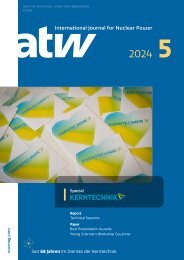Create successful ePaper yourself
Turn your PDF publications into a flip-book with our unique Google optimized e-Paper software.
<strong>atw</strong> Vol. 62 (<strong>2017</strong>) | Issue 6 ı June<br />
396<br />
OPERATION AND NEW BUILD<br />
does not require electrically driven<br />
components. Westinghouse determined<br />
the required amount of water<br />
spray needed to cool the spent fuel<br />
pool during Design Extension Conditions<br />
A and B analytically; designed<br />
the system’s hydraulics to provide<br />
sufficient flow rates for the volume;<br />
defined the corresponding pipe<br />
diameters; and determined the pipe<br />
routing, based on the on the local<br />
space restrictions around Krško<br />
Nuclear Power Plant’s spent fuel pool.<br />
Westinghouse also conducted experimental<br />
testing at the Lechler GmbH<br />
Technology Center Metzingen to determine<br />
the coverage and distribution of<br />
the spent fuel pool spray nozzles and<br />
to confirm the spray height, setting<br />
angle horizontal orientation, pressure<br />
and volume of water flow.<br />
The spent fuel pool spray system is<br />
planned to be installed by the end of<br />
<strong>2017</strong>.<br />
References<br />
[1] Western European Nuclear Regulators<br />
Association (WENRA): WENRA Safety<br />
Reference Levels for Existing Reactors,<br />
September 2014.<br />
[2] Nuclear Energy Institute (NEI): B.5.b<br />
Phase 2 & 3 Submittal Guideline,<br />
Revision 2, NEI <strong>06</strong>-12, December 20<strong>06</strong>.<br />
[3] Sandia National Laboratories:<br />
Mitigation of Spent Fuel Pool Loss-of<br />
Coolant Inventory Accidents And<br />
Extension of Reference Plant Analyses<br />
to Other Spent Fuel Pools, Sandia Letter<br />
Report, Rev. 2, November 20<strong>06</strong>.<br />
[4] Lechler GmbH, Technology Center<br />
Metzingen.<br />
Authors<br />
Dipl.-Ing. Christoph Hartmann<br />
Project Engineer Safety<br />
Engineering<br />
Dr.-Ing. Zoran Vujic<br />
Marketing Manager Business<br />
Development<br />
Westinghouse Electric Germany<br />
GmbH<br />
Dudenstraße 6<br />
68167 Mannheim, Germany<br />
Cyber Security in Nuclear Power Plants<br />
and its Portability to Other Industrial<br />
Infrastructures<br />
Sébastien Champigny, Deeksha Gupta, Venesa Watson and Karl Waedt<br />
Introduction This technical contribution provides a snapshot of the current cyber security efforts in different<br />
industry domains. We argue that stringent security controls (countermeasures) that are already in place for nuclear<br />
power plants (NPP) can be ported to other industry domains. A reason for this is that the nuclear domain is more<br />
formally regulated, thus graded security requirements were already mandated long before the critical infrastructure<br />
debates started and before gradual enforcement of the European and national legislation.<br />
Note: Generally, in the nuclear and<br />
industrial automation domain, the<br />
term “control” is used mainly to<br />
denote Instrumentation and Control<br />
(I&C), Industrial Automation and<br />
Control Systems (IACS) or SCADA<br />
(Supervisory Control and Data Acquisition)<br />
referring to control theory<br />
tasks. However, in the security context,<br />
the term “Security Control” is<br />
ubiquitous, and means any countermeasure<br />
that can reduce the systems<br />
risk due to security threats. Countermeasures<br />
are not limited to add-on<br />
provisions at the components or systems<br />
level. For example, they also include<br />
provisions at the software<br />
source code level.<br />
In Section 1, we will provide an<br />
overview of current international and<br />
national cyber security guidance, and<br />
how this guidance evolved for International<br />
Atomic Energy Agency (IAEA),<br />
Nuclear IEC and selected countries.<br />
Section 2 summarises the increasing<br />
cyber security efforts for Industrial<br />
Automation and Industry 4.0 as well<br />
as its Chinese “Manufactured in China<br />
2025” and US “Industrial Internet of<br />
Things” counterparts. Section 3<br />
provides reasons for the portability<br />
of Security Controls from Nuclear<br />
to other industrial infrastructure.<br />
Summary provides an outlook on the<br />
newest cyber security-related activities<br />
in the different domains, and<br />
concludes with a summary of the<br />
main steps that are necessary for<br />
achieving and maintaining a target<br />
security level.<br />
1 Cyber security and safety<br />
requirements for NPPs<br />
In the nuclear domain, for Safety,<br />
Human Factors Engineering, Physical<br />
Security, Radiation Protection and<br />
Cyber Security, the international<br />
top-level guidance is provided by the<br />
IAEA. The IAEA guidance is regularly<br />
updated based on priorities set by<br />
yearly or bi-yearly meetings of representatives<br />
of all IAEA member states.<br />
The overall IAEA Cyber Security<br />
guidance is refined, e.g. for Instrumentation<br />
& Control (I&C) and<br />
Electrical Systems (ES), by the<br />
Nuclear IEC subcommittees. However,<br />
each country may supersede the<br />
international guidance by providing a<br />
mandatory higher priority regulation,<br />
as will be addressed in section 1.4 for<br />
selected countries.<br />
1.1 Stringent and graded<br />
security requirements for<br />
I&C already since 1986<br />
Safety and security grading are<br />
essential when addressing critical<br />
industrial infrastructures. Grading by<br />
Safety Categories in IEC 61226 and<br />
Safety Classes in IEC 61513, were<br />
already in place since the first editions<br />
of these standards. The softwarespecific<br />
requirements for software<br />
implementing Category A or Category<br />
Operation and New Build<br />
Cyber Security in Nuclear Power Plants and its Portability to Other Industrial Infrastructures ı Sébastien Champigny, Deeksha Gupta, Venesa Watson and Karl Waedt

















